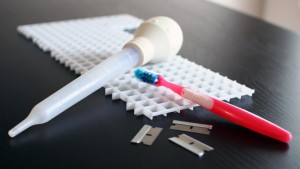Visit your local fish store, and you’ll see shelf after shelf of equipment, implements, doodads, and thingamabobs specifically designed to make the maintenance of marine aquariums more manageable. But when you really think about it, a lot of the handy tools and materials we hobbyists use on a daily basis come not from the LFS, but from hardware stores, housewares departments, supermarkets, or other retail venues not even remotely related to the aquarium hobby.
Here, in no particular order, are six such items that I can’t live without:
1) Single-edged razor blades
I’m never without at least one cartridge of these little wonders. No aquarium scraper seems to get algae (especially coralline) off the glass panes of my aquariums with as much ease.
I also use a razor blade to carefully dislodge pulsing Xenia corals from the rear pane of my reef tank so I can then rubber band them to rocks or rubble and, once the corals have attached completely, trade them with Mark, Susan, and Nikki at Coral Reef for store credit.
I’m always careful to rinse the blade in fresh water and dry it thoroughly after each use. Also, be aware that razor blades cannot be used on acrylic tanks, as doing so will cause severe scratches.
2) Plastic milk jugs
A well-rinsed one-gallon plastic milk jug (juice jug, punch jug, etc.) has long been my go-to container for holding the fresh water I use for top-offs. You can also use one of these ubiquitous vessels to construct a basic DIY kalkwasser doser if you’re so inclined.
To do so, simply drill a small hole in the side of the jug about 3 inches up from the bottom, insert one end of an appropriately sized length of airline tubing into the hole so it protrudes inside the jug slightly, seal around it with aquarium-safe silicone, and then attach an adjustable clamp or valve to the opposite end of the tubing.
After the kalkwasser powder is mixed with purified water in the jug, any powder that doesn’t dissolve (which you don’t want in your tank) will settle to the bottom, below the level of the airline tubing. So, when you’re ready to dose your tank, all you have to do is extend the tubing down to the sump or tank (obviously, the jug will need to be placed at a higher level than the tank/sump you’re dosing) and adjust the clamp or valve to a slow drip.
3) 20-gallon plastic storage containers
They may not be designed for aquarium purposes, but heavy-duty plastic storage bins are ideal containers for holding clean salt water, temporarily holding specimens, transporting water and livestock, curing live rock, etc., etc. Some frugal hobbyists even use them for sumps or refugiums. The emphasis, however, is on “heavy-duty.” Not all plastic storage containers will hold up under this type of use, so some common sense is definitely in order. Also, it’s important to make sure the container never held any potentially toxic substances before using it for any aquarium-related task.
4) Toothbrush
A toothbrush isn’t only good for keeping your teeth as white as they can be; it’s also a great tool for cleaning heaters, pumps and powerheads, filter and skimmer parts, the inside corners of aquariums, and just about any other aquarium component you can think of. I even use one to gently brush debris off my live rock in areas where the water movement isn’t as brisk as it should be.
5) Turkey baster
Target feeding fish and corals, siphoning out uneaten food, liberating detritus from tight corners, blasting sand and debris off live rock, and acclimating fish are just a sampling of the many uses I’ve found for a turkey baster.
6) Egg crate light diffuser
Usually sold in hardware/home-improvement store lighting aisles in large sheets, egg crate light diffuser comes in handy for aquarists in more ways than one. This plastic grid-like material is easily snipped or cut into sections of different sizes and shapes. I use it for makeshift aquarium covers, e.g., for my quarantine tank. Also, on several occasions, I’ve constructed simple stair-step frag racks for propagating corals. Another use, recommended by Saltwater Smarts reader Matt Bowers, is as an underlayment for rockwork to help diffuse the weight on the bottom of the tank.



